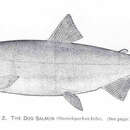Diagnostic Description
(
Inglês
)
fornecido por FAO species catalogs
Body elongate, but becoming deeper with age, spawning males becoming slightly hump-backed. Tip of upper jaw reaching to somewhat behind eye, snout and lower jaw becoming somewhat hooked in spawning males (less so than in O. gorbuscha). Gillrakers 19-25. Piloric caeca numerous, 121-185. Dorsal finrays iii-iv + 9-11, and an adipose fin behind it; pelvic finray i-ii 8-11, base below about middle of dorsal fin. Anal finrays iii + 12-15. Caudal fin slightly forked. Scales small, 125-150 in lateral line. Vertebrae 65-71. Colour bright silvery with no distinct black spots; spawning males dark olive, flanks reddish grey with crimson or lilac bars, females less distinctly marked.
- Ida, H. - 1984 Salmonidae. In: H. Masuda; K. Amaoka; C. Araga; T. Uyeno; T. Yoshino (eds.). The Fishes of the Japanese Archipelago. Tokai. Univ. Press. 40.
- Scott, W.B. & E.J. Crossman.- 1973Freshwater Fishes of Canada. Fisheries Research Board of Canada, Bulletin 184: 966 pp.
Distribution
(
Inglês
)
fornecido por FAO species catalogs
From the rivers of Chôshi and the eastern Korean Pen., to northern California. Chum salmon consist of two large races (Ida, 1984), Asiatic and North American. The Asiatic is divided into Japanese and Okhotsk populations, and the latter into Alaskan and British Columbia to Oregon populations. Autumn populations from Pacific introduced into rivers affluent to White and Barents Seas (1930-45, 1957-62), but maturation too late in year (September/October) and none have survived; planting of summer populations will be attempted in the future.
Size
(
Inglês
)
fornecido por FAO species catalogs
To about 100 cm and 4.9 kg ; usually 60-75 cm.
Brief Summary
(
Inglês
)
fornecido por FAO species catalogs
Anadromous, pelagicat 0-50 m. Deeper in winter, forming dense shoals during spawning run and making considerable migrations; juveniles in mouths of rivers and bays.Feeds on fishes (herring, sand eels, smelt), also crustaceans; young at sea on crustaceans (harpacticoids, calanids, amphipods); in freshwater, adults do not feed.Summer population enters rivers early July to late August. Spawning from mid-August; autumn population enters rivers from mid-August, spawning from mid-September at 2-8 years old (usually 3-4); adults die after spawning shoals in estuarine areas and often remaining near the shore for several months and at sea for 3-5 years. Fecundity varies greatly with body-size, 2000 to 5000 eggs. Development of eggs also varies greatly with water temperature. Fertilization to hach-out to absorption of yolk requires 48 days at 107deg; C.
Benefits
(
Inglês
)
fornecido por FAO species catalogs
Utilized for caviar; marketed mostly canned but also fresh, dried/salted, smoked and frozen; eaten steamed, fried, broiled, boiled, microwaved and baked. Was once used as dog food in Canada. The total catch reported for this species to FAO for 1999 was 281 259 t. The countries with the largest catches were Japan (182 866 t) and USA (65 295 t).

